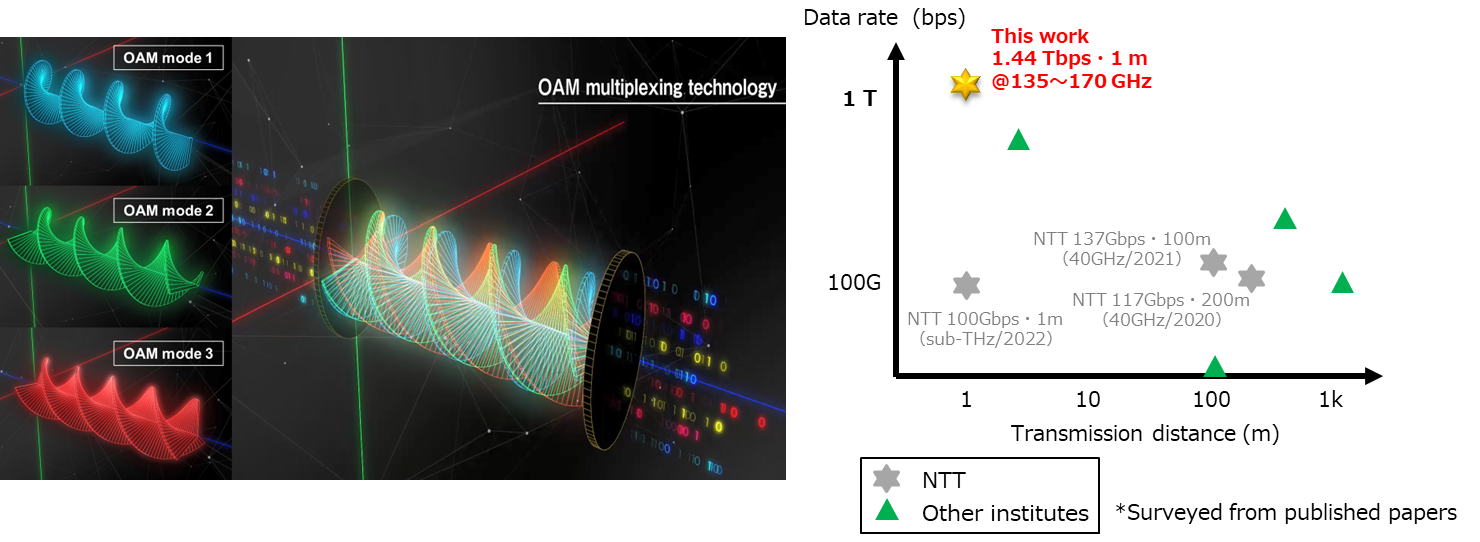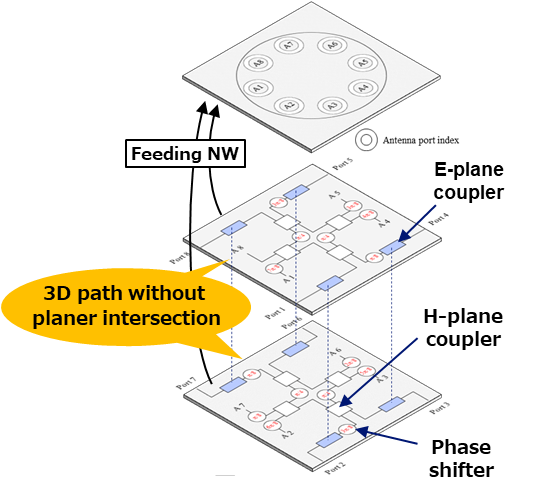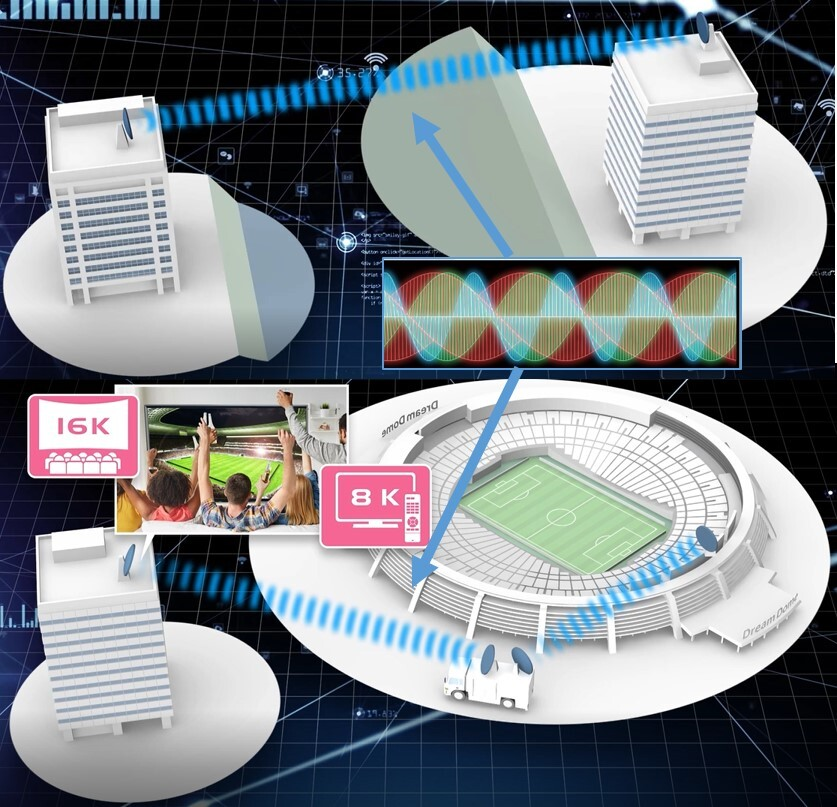Microsoft ends support for Internet Explorer on June 16, 2022.
We recommend using one of the browsers listed below.
- Microsoft Edge(Latest version)
- Mozilla Firefox(Latest version)
- Google Chrome(Latest version)
- Apple Safari(Latest version)
Please contact your browser provider for download and installation instructions.
March 30, 2023
NTT Corporation
World's First Successful 1.4-Tbit/s Wireless Transmission in the Sub-THz Band
-Contributing to the Creation of New Wireless Services Enabled by IOWN and 6G-
Aiming to implement terabit-class wireless transmission to support wireless demand in the 2030s, NTT Corporation (NTT, headquartered in Chiyoda-ku, Tokyo; Akira Shimada, President & CEO) has successfully achieved the world's first "orbital angular momentum (OAM)*1 multiplexing high-capacity wireless transmission—at 1.44 Tbit/s—using an ultra-wide bandwidth of 32 GHz. As an innovative wireless-communication technology that uses the sub-terahertz (sub-THz) band between 135 and 170 GHz*2, this achievement will enable wireless access to vast amounts of information at data-transfer rate exceeding 1 Tbit/s. This achievement was realized using the sub-THz band from 135 GHz to 170 GHz, and is an innovative wireless communication technology that enables wireless access to a huge amount of information exceeding 1 Tbit/s. As a key element of the "Innovative Optical and Wireless Network" (IOWN), which we aim to implement with our global partners, it is an extension of the high-capacity communication network and information-processing infrastructure centered on light to wireless networks including 6G. We expect the development of this technology to contribute to the creation and popularization of various future services including VR/AR (virtual reality/augmented reality), high-definition video transmission, connected cars, and telemedicine. This technology will be presented in detail at the IEEE ICC (International Conference on Communications) to be held from May 28, 2023.
 Figure 1: Image of OAM-multiplexing transmission technology and trends in high-capacity wireless transmission
Figure 1: Image of OAM-multiplexing transmission technology and trends in high-capacity wireless transmission
1. Background of research
Aiming to support the high-capacity network and information processing infrastructure of the IOWN and 6G and prepare for the increasing future demand for wireless communications, NTT is engaged in research and development with the goal of achieving terabit-class wireless transmission. Capacity of wireless communications can be increased by taking three approaches: (i) increasing the spatial multiplexing order*3, (ii) increasing transmission bandwidth, and (iii) increasing number of modulation levels. Taking approaches (i) and (ii), NTT is increasing the spatial multiplexing order by applying on a new principle using radio waves with "orbital angular momentum" (OAM) to increase wireless-transmission capacity and using the sub-terahertz (sub-THz) band to increase transmission bandwidth.
OAM is a physical quantity that describes the properties of radio waves, and radio waves with OAM (so-called "OAM waves") have identical phase trajectories with a helical structure that spirals in the direction of travel (Figure 1). OAM waves can only be received by receivers with the same helical structure (like the relationship between a nut and bolt, for example). Accordingly, multiple OAM waves with different spiral structures can be superimposed and separated without causing them to interfere with each other if we use a receiver that can receive each OAM wave with its corresponding spiral structure. OAM multiplexing transmission technology uses this feature to transmit multiple data streams simultaneously. Since the 2010s, results of research on OAM multiplexing transmission using millimeter wave bands, have been reported globally. NTT has also conducted demonstration experiments*4 of OAM multiplexing transmission over 100 m at 100 Gbit/s by using millimeter wave bands (Fig. 1).
2. Results of current research
The approach taken by NTT is to use an analog circuit called a "Butler matrix" to increase the spatial multiplexing order by multiplexing multiple OAM waves. This approach reduces the enormous amount of digital signal processing required to eliminate interference between multiplexed data streams in high-capacity communications exceeding one terabit.
In this research, NTT has promoted research and development of sub-THz-band waveguide technology and succeeded in developing an antenna-integrated Butler matrix that operates with a wide bandwidth and low loss (Figure 2). The antenna-integrated Butler matrix is designed to simultaneously generate and separate eight different OAM waves over a very wide bandwidth, i.e., 135 to 170 GHz, which can be used to multiplex and transmit eight data signals. Moreover, by performing OAM multiplexing transmission with two different polarizations, it is possible to multiplex and transmit twice as many data signals simultaneously without them interfering. We conducted transmission tests using the antenna-integrated Butler matrix, and we achieved the world's first successful large-capacity wireless transmission totaling 1.44 Tbit/s in the sub-THz bands of 135.5 to 151.5 GHz and 152.5 to 168.5 GHz (Figure 2). This transmission capacity is equivalent to the speed of simultaneous transmission of approximately 35,000 ultra-high-definition 4K videos (at about 40 Mbit/s) that can be available on current video websites. This speed enables the simultaneous transmission of 140 or more uncompressed 4K videos (at about 10 Gbit/s) for applications that require ultra-low latency.
 Figure 2: Antenna-integrated Butler matrix developed for the sub-THz band and transmission experiments using the Butler matrix
Figure 2: Antenna-integrated Butler matrix developed for the sub-THz band and transmission experiments using the Butler matrix
3. Technological points of note
- To transmit eight OAM waves simultaneously by using the Butler matrix, the phase of the radio waves must be controlled with extremely high precision. Since the phase of radio waves varies with frequency, it is extremely difficult to control the phase uniformly over a wide bandwidth by using an analog circuit. In this research, we first analyzed the unique radio-wave propagation in a waveguide, which is different from free space, and developed a phase shifter that can theoretically align the advance of phases uniformly over a wide bandwidth.
- By designing a multilayer three-dimensional path (Figure 3) that includes the aforementioned phase shifter so that all paths are electrically equal in length and planar intersections in the circuit (which degrade performance) are eliminated, we have successfully developed a prototype Butler matrix that can provide the necessary phase for each OAM mode over 35-GHz width.
- One characteristic of this Butler matrix is that it is designed as a hollow waveguide, and compared to general dielectric-substrate circuits, it can prevent dielectric loss and radio-wave leakage, so it achieves low loss despite being a high-frequency circuit.
 Figure 3: Schematic illustration of multilayer three-dimensional path of the Butler matrix
Figure 3: Schematic illustration of multilayer three-dimensional path of the Butler matrix
4. Future developments
This technology is expected to enable (i) broadband and high-speed wireless transmission comparable to optical transmission systems and (ii) seamless connection between wireless and optical transmission systems without the need for a complex digital signal-processing system for spatial multiplexing, since the analog circuit (i.e., the Butler matrix) handles the multiplexing of OAM waves. The next step in this development is to conduct demonstrations over longer distances (exceeding 100 m) while envisioning various applications of this technology in the real world, including wireless backhaul/fronthaul between base stations and relay transmission (Figure 4). We expect the eventual development of this technology to support the creation and spread of various future services, such as VR/AR (virtual reality/augmented reality), high-definition video transmission, connected cars, and telemedicine, as innovative wireless-communication technology in the IOWN and 6G era.
 Figure 4: Example applications of this technology (top: wireless backhaul/fronthaul; bottom: temporary wireless link to transmit uncompressed 8K/16K video)
Figure 4: Example applications of this technology (top: wireless backhaul/fronthaul; bottom: temporary wireless link to transmit uncompressed 8K/16K video)
【Glossary】
*1Orbital angular momentum. One of the properties of radio waves, expressed as the product of the positional coordinate and its conjugate momentum, is the angular momentum that radio waves with different orbital angular momenta are uncorrelated and can be superimposed and separated independently.
*2Sub-terahertz band
The sub-terahertz band refers to the frequency range between 100 GHz and 1 THz. It is characterized by extremely short wavelengths (ranging from several hundred micrometers to several millimeters) and strong linearity.
*3Spatial multiplexing
A transmission method by which multiple data series are transmitted in parallel by using multiple spatially independent radio waves simultaneously and in the same frequency band.
*4NTT news release: "NTT successfully demonstrates 100 Gbps wireless transmission using a new principle (OAM multiplexing) as a world's first --New groundbreaking technology for achieving next generation of 5G systems--"
https://group.ntt/en/newsrelease/2018/05/15/180515a.html
Media Contact
NTT Corporation,
Science and Core Technology Laboratory Group, PR Office
nttrd-pr@ml.ntt.com
Information is current as of the date of issue of the individual press release.
Please be advised that information may be outdated after that point.
NTT STORY
WEB media that thinks about the future with NTT










